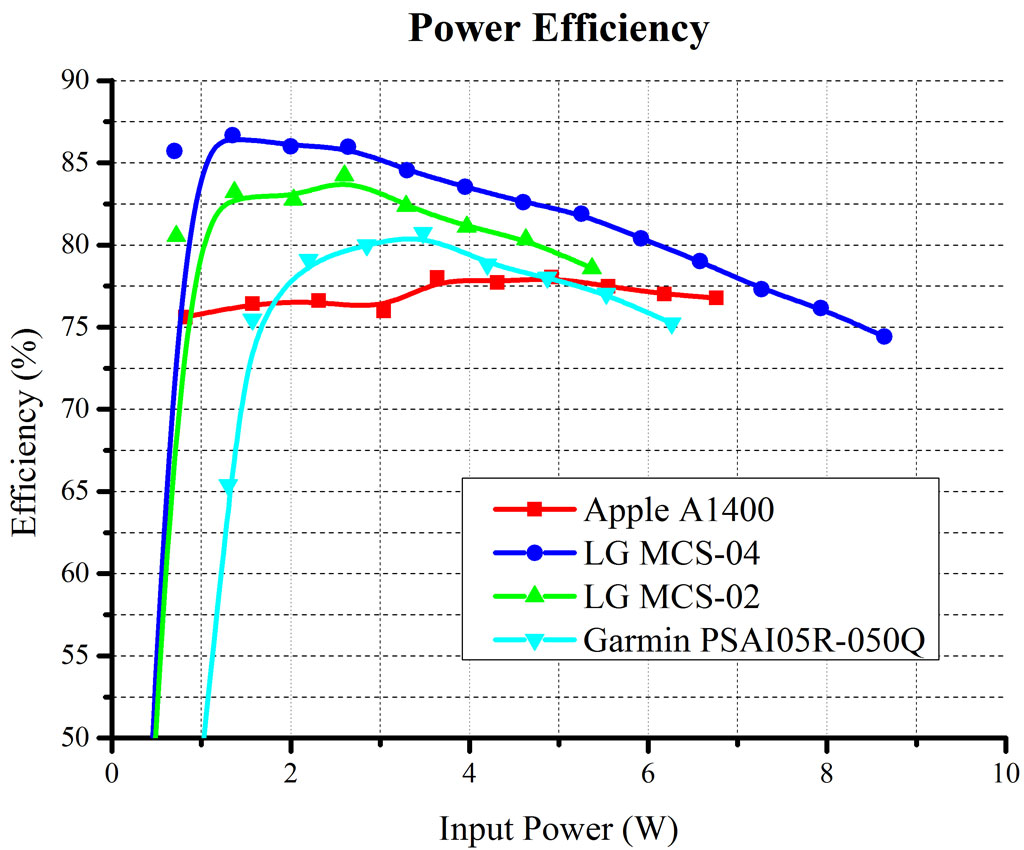Single or multiple USB power sources
April 06, 2021 -The other day I was thinking about power consumption of different low power devices, since many small devices may add up to some significant energy usage, sometimes known as Vampire power.
I was asking myself:
if you have multiple USB powered devices, each with their own power supply, would they draw the same, more, or less power than if they would be powered by a single power supply?
Power supply efficiency
Why would it matter if you use multiple small power supplies or one big one? It has to do with power supply efficiency.
The function of a USB power supply is to convert from AC (e.g. 230 Volt) to DC. To state it simply: the efficiency of a power supply is measured as the power delivered on the DC side divided by the power draw on the AC side. For example, if a device is using 5V, 1 Ampere (= 5 Watt) on the DC side and the power supply would use 6 Watt on the AC side, then the efficiency would be 5 W / 6 W = 83.33%.
 The efficiency of a power supply depends on the load and the type/model. When a device is idle, it is likely that it
will use (a lot?) less power than when it's active. Is the efficiency of the power supplies low when the devices are
idling, or did the manufacturers make sure that the efficiency of their power supplies are high even then?
The efficiency of a power supply depends on the load and the type/model. When a device is idle, it is likely that it
will use (a lot?) less power than when it's active. Is the efficiency of the power supplies low when the devices are
idling, or did the manufacturers make sure that the efficiency of their power supplies are high even then?
Test setup
In my case, I have four devices:
- An IKEA TRÅDRFRI gateway (with an IKEA power supply),
- A Sure Petcare Hub (with a Sure Petcare power supply),
- A Raspberry PI 3B+ (with a Raspberry PI power supply),
- NanoPI R4S (with a power supply that the webshop offered as a package deal).
My power meter is not very precise: the smallest increment is 1 Watt. I have no idea about accuracy. I have seen it display 0 Watt while the device was on, so the device is probably drawing power below a certain threshold measurable by my power meter. I figured if I measure all devices together on a power strip, I will get a better reading because I will be over the minimum measurable power, and I do not have 4 times the error margin, but only once.
I measured the power with the supplied (no pun intended) power supplies, and then I plugged everything in an Anker PowerPort Atom III Slim and measured again (still with the power strip to remove any potential bias the power strip might add).
Results
The results are shown in the table below:
| Test | Energy consumption, measured on the AC side |
|---|---|
| Four power supplies | 8 Watt |
| One multiport USB charger | 6-7 Watt |
So it does look like one USB charger is slightly more efficient than four separate ones, even though those power supplies came with the devices and are supposedly designed/picked to match the power consumption of the devices.
Discussion
Is all this effort worth it?
Let's assume the worst case scenario first. I have bought an extra device and can't use the other devices. I paid around € 50 (I also bought some cables because some of those devices had the cables attached to the power supply). With our current energy contract we pay around € 0.185 per KWh. Assuming 365 days in a year and 1 Watt difference, we would save around 8.76 KWh, or € 1.62 per year. We would break even in 30.8 years. For 2 Watt difference, we would break even in 15.4 years.
This of course assumes that I will only gain financially on the electricity costs.
Let's assume the best case scenario: say I can re-use the freed up power supplies in other places where it is harder to combine several devices. That saves me from buying new USB chargers in those places. Let's say that saves me from having to buy 4 of them at € 10 a piece (you can get them cheaper, but I'm stretching the best case scenario here). Then (to stretch it further), because it frees up three electricity outlets I can also free up a power strip that I can use elsewhere, saving me from buying that there. Let's say that saves me from spending another € 5. Even then we would only break even at between 3 or 1.5 years (1 or 2 Watt difference).
Conclusion
So financially I think this was not worth it, since my case is not the best case. In a more realistic scenario, I'll probably replace devices anyway before the break even point.
Having only one power supply does free up some power outlets, it looks a bit nicer in my utility closet, and I learned something new. For me, it was a win.
